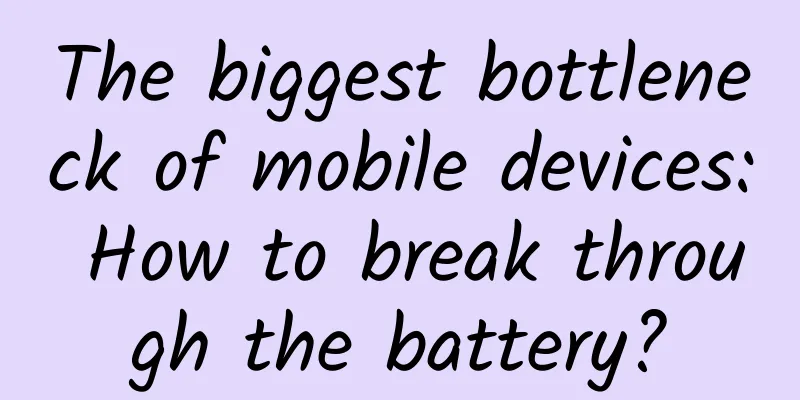The biggest bottleneck of mobile devices: How to break through the battery?

|
ReadWrite, a US technology blog, recently wrote an article analyzing the current status of battery technology used in mobile devices, and believed that if a breakthrough is not achieved in this field as soon as possible, it may hinder the future development of the mobile industry. The following is the full text of the article: One day in the future, my body, pockets and house will be full of various smart devices, and I can control almost everything in my life just by voice, gestures or finger clicks. This experience is really cool-but the only drawback is that I can't get rid of the shackles of messy wires. These unsightly wires make this scene that should be full of happiness instantly become dull: if I forget to charge my mobile phone or wearable device, or forget to bring spare batteries and charging cables, I will be instantly back to square one-the connection between all devices will be cut off. This is really a pity. Today's era is experiencing rapid innovation, but battery technology is not moving forward. Major companies are making every effort to make up for this shortcoming through workarounds, but workarounds are only workarounds after all, and they can never completely solve the problem. At the same time, more and more devices, apps, and accessories are becoming more mobile, so today's minor annoyances can become tomorrow's major problems, or even far-reaching systemic problems. If the future world is indeed to rely on batteries, humans have a long way to go. Short battery life When I leave home, my phone tells my smart home system to turn off all the lights in the room. My smartwatch also vibrates when I receive a text message. It's not important information, so I just keep walking. The data from my fitness tracker shows that I slept well the night before, so my steps are light. But I'm not in a hurry because the information on my phone shows that the bus is seven minutes late, so I have plenty of time. So I answer a call from a friend using my Bluetooth wireless headphones. My whole body is integrated into the wireless network, and the smartphone is at the center of it all. Soon, my battery is exhausted. So I'm back to 1989. I have to use paper maps to check the road, ask strangers around me for directions, and keep in touch with people through almost extinct pay phones. I went to a coffee shop that accepted PayPal payments, but I couldn't launch the app, so I had to dig out a few coins from the back of my pocket to buy a cup of coffee. Finally, I arrived at my home, but the smart home system had no idea what was going on. So I had to use the mechanical key to open the door and grope my way to the light in the dark. It was pitch dark, so my calves were bruised from bumping into various furniture. As much as I hate to admit it, this is not a coincidence. Fortunately, I usually stay close to home. But international travelers may not be so lucky due to new regulations introduced by the Transportation Security Administration. Foreigners flying into the United States must make sure their electronic devices can be turned on before going through security. If you are selected for inspection and your phone, tablet, e-reader and other devices cannot be turned on, you may be denied boarding. Imagine if you were in this situation, what would you choose: would you throw away your phone to get on the plane? Or risk missing the plane and find an outlet to charge your device? What if your charger or charging cable is in your checked luggage? These are tough choices, but given current battery technology, they’re inevitable for many people. No Batteries, No Mobility Most of the time, I carry a charger, a charging cable, and an external battery with me—and an extra one when I travel. It’s important to be prepared, but I’ve grown tired of the constant battery failures of my wireless earbuds, fitness trackers, e-readers, tablets, hotspots, and laptops. Of these devices, the iPhone is undoubtedly the most important. From the first iPhone in 2007 to the latest iPhone 5s, Apple’s smartphone battery capacity has only increased by 12%. The first iPhone had 1400 mAh, and the iPhone 5s has about 1570 mAh. Compared to the 2800 mAh of the Samsung Galaxy S5, this is indeed pitiful, but the latter has increased the battery capacity while increasing the screen size to 5.1 inches, which is basically no substantial change. Apple has also made some optimizations to the iOS software while taking energy consumption into consideration. Because of this, the estimated battery life of the iPhone has remained roughly the same throughout. That's a big deal, given the iPhone's new Retina display and more powerful processor. But in practice, it doesn't improve the user experience much. Despite Apple's efforts to make its software more energy efficient—for example, iOS stops background apps after a period of inactivity—I still struggle to get a full day's battery life out of my iPhone. Granted, I'm a heavy gadget user, and I connect my iPhone to a lot of other devices and services. But if the tech industry's utopian connected world comes to fruition, I'm sure most of us will find ourselves in a similar situation. Rumor has it that Apple will release two larger iPhone 6 models—a 4.7-inch version with an 1,800-mAh battery and a 5.5-inch version with a 2,500-mAh battery, respectively. Even if that's true, it won't make much of a difference, since bigger phones use more power. And Apple's competitors: The latest iteration of its Android operating system could bring some relief to the larger-screened Android camp. Android L, which will be available on the Nexus 5 smartphone and Nexus 7 tablet, will include Project Volta, a power-saving feature that can extend battery life by up to 36 percent. Such is the state of mobile technology today: In the absence of more powerful batteries, companies must come up with workarounds to squeeze as much life out of existing batteries as possible. Wearables present a tough challenge Battery life may be even more of a problem for wearables, where manufacturers can’t afford to use larger batteries because of the size of the devices. That’s forced companies like Pebble to compromise. The startup eschewed LCD screens in favor of more energy-efficient e-ink displays, which give it four to seven days of battery life. Others, like LG, seem in denial: The LG G Android Wear smartwatch uses a 1.5-inch full-color touchscreen that’s both user-friendly and visually appealing. Unfortunately, it only lasts about a day and a half on a single charge. Some wearables, like the Shine, Ringly, and Jawbone UP24, are even ditching screens altogether, relying entirely on mobile apps and the phone’s screen to display data. At least these devices won’t drain your phone’s already limited battery capacity like traditional accessories do. You can credit Bluetooth Low Energy (BLE) for this. Traditional Bluetooth consumes a lot of your smartphone’s battery because it needs to be connected all the time. But with BLE, the technology is much more efficient. BLE may save energy, but it can’t really increase the capacity of your smartphone’s battery or the devices that rely on it. The only way to solve this problem is a new generation of battery technology. Where are the battery breakthroughs? Engineers and scientists are stepping up their research on the next generation of battery technology, and some have even made some inspiring breakthroughs. The problem is that not many of them are actually commercially available. Graphene batteries can store more power in a smaller space and lighter weight, but still maintain stability. Silicon beads have also been shown to increase the capacity of lithium batteries in mobile phones. Microbatteries have also reimagined how the positive and negative electrodes work, producing small but powerful batteries. Today, researchers are very interested in air electrode technology, which can double the life of mobile phone batteries at a lower cost. Scientists are still working on carbon nanomaterials and other nanotube technologies to physically restructure the microstructure of batteries for better performance and durability. Some projects hope to change battery materials, while others simply hope to improve existing lithium battery technology. Research shows that silicon sponge can improve the performance of lithium batteries because it has ultra-thin supercapacitor plates that can be used as an independent energy source. This all sounds great, but what devices use these batteries? None, because none of these technologies have been commercialized. If there is a glimmer of hope, it is Amprius. This Silicon Valley startup has just made a new type of lithium battery that can increase the capacity of existing batteries by about 20%. Unlike other new battery technologies, the company's products have already been shipped. They have raised $30 million in funding to develop products that are expected to increase the capacity of existing lithium batteries by 50%. Hopefully, this goal will be achieved sooner rather than later. But despite this, it still cannot substantially change the capacity of mobile batteries. It is urgent to develop more advanced battery technology as soon as possible. If this day comes too late, it may cause the future of mobile technology to stagnate. As a winner of Toutiao's Qingyun Plan and Baijiahao's Bai+ Plan, the 2019 Baidu Digital Author of the Year, the Baijiahao's Most Popular Author in the Technology Field, the 2019 Sogou Technology and Culture Author, and the 2021 Baijiahao Quarterly Influential Creator, he has won many awards, including the 2013 Sohu Best Industry Media Person, the 2015 China New Media Entrepreneurship Competition Beijing Third Place, the 2015 Guangmang Experience Award, the 2015 China New Media Entrepreneurship Competition Finals Third Place, and the 2018 Baidu Dynamic Annual Powerful Celebrity. |
<<: Why do we still rely on TV to watch the World Cup?
Recommend
The latest news on the 2022 grain planting subsidy policy: How much is the grain planting subsidy per acre? Who are the recipients of the subsidy?
Starting from 2021, the central government began ...
The secret of natural radioactivity has been discovered: this is the first time that nuclear changes have been observed
On February 21, 1896, French physicist Henri Becq...
How to analyze user needs and build a user system?
1. What is the user system? Before talking about ...
Technology News | Self-reproducing living robot is launched
[Today's cover] On the 30th, Mount Tai after ...
The Woodpecker, the “Forest Doctor”? Is the Woodpecker a “Good Doctor”?
When talking about woodpeckers, the first thing t...
Can WeChat Mini Programs really make money? Can WeChat Mini Programs make money?
Can WeChat Mini Programs really make money? Can W...
Zhang Chaoyang's Sogou Ma Huateng's Sogou
Sogou, which had originally planned to go public ...
Is a "new virus" coming? Don't believe these rumors about respiratory diseases!
Mycoplasma pneumoniae infection, mononucleosis, i...
Is operation and promotion difficult? You can't handle these three user attributes
The categories of operations include data operati...
Why do many companies attach so much importance to search marketing?
Why should enterprises do search promotion? What ...
Seize the peak season for wedding dress marketing and make your promotion more effective!
The beginning of autumn has passed in the blink o...
Flower Arrangement Bonsai Video Tutorial Baidu Cloud Download
Flower arrangement and bonsai video tutorial for ...
Crazy Xiao Yangge: E-commerce will not cause the real economy to fall, it will only make goods cheaper
Recently, some people believe that the developmen...
How to create a differentiated brand image and make the industry leader unable to fight back?
-1- If you become number one in a small market, t...
Samsung is at most "stepping down" from the altar, not falling into the abyss
Recently, many people have been pessimistic about...









